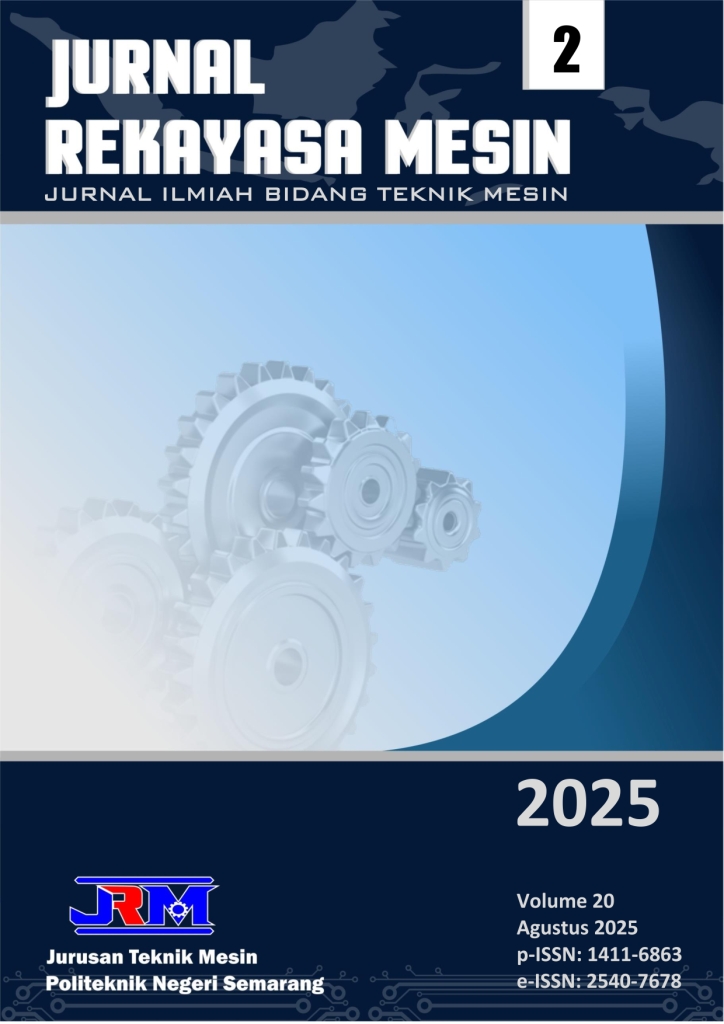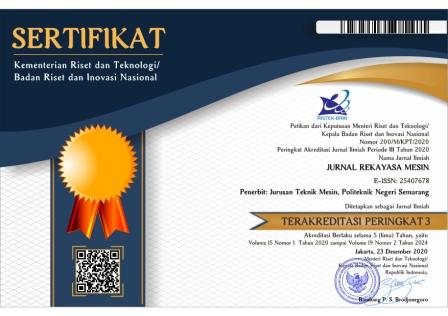Optimization of Barium Sulfate (BaSO₄) Crystallization Using the Box-Behnken Design Method to Mitigate Scaling in Industrial Pipes
DOI:
https://doi.org/10.32497/jrm.v20i2.6694Keywords:
Barium Sulfat (BaSO₄), Metode Box-Behnken Design, Asam Tartrat, Mitigasi Scaling, Sistem Perpipaan IndustriAbstract
The precipitation of barium sulfate (BaSO4) in industrial piping systems is a major problem because it causes blockage, decreased productivity, and structural damage, including pipe rupture. Although there has been progress in understanding the mechanism of BaSO4 formation, some elements, such as the interaction of tartaric acid with BaSO4 crystals, the best parameters for reducing scaling, and the effectiveness of gas hydrate inhibitors, are still not fully understood. The objectives of this study were to find out how tartaric acid and BaSO4 crystals interact, find the ideal parameters to prevent scale formation, and assess the effectiveness of scaling inhibition techniques using gas hydrate inhibitor and scaling theories. This study used a Box-Behnken experimental design in the laboratory to optimize the temperature, solution concentration, and tartaric acid additive. The test was carried out under laminar flow conditions with a flow rate of 30 mL/min. After that, the morphology and composition of the scale were analyzed by SEM-EDX and XRD. The main results of the study showed that, under ideal conditions, the addition of tartaric acid significantly prolonged the induction time and reduced the mass of BaSO4 scale by up to 50%. This study reached the main conclusion that tartaric acid functions well as an anti-scaling agent and that ideal parameters can be used to effectively prevent scaling. This study is very helpful in developing more efficient and sustainable BaSO4 scaling mitigation methods for industrial applications.
References
[1] M. Gruszka and S. Nagy, “Precipitation of Barium Sulphate during the Waterflooding Process in Polish Offshore Oilfields—Case Analysis,” Energies, vol. 16, no. 8, pp. 1–14, 2023, doi: 10.3390/en16083345.
[2] N. Karaman, H. Giritama Wibowo, U. Aqil, J. Jamari, A. P. Bayuseno, and L. Suprianti, “Inhibition of Barium Sulfat Crystal Formation in a Batch Method Crystallizer in the Presence of Cu and Zn,” Int. J. Sci. Technol. Manag., vol. 4, no. 3, pp. 697–701, 2023, doi: 10.46729/ijstm.v4i3.824.
[3] C. Dai et al., “Prediction models of barite crystallization and inhibition kinetics: Applications for oil and gas industry,” Sustain., vol. 13, no. 15, 2021, doi: 10.3390/su13158533.
[4] I. Mohammed et al., “Effect of Sulfate-Based Scales on Calcite Mineral Surface Chemistry: Insights from Zeta-Potential Experiments and Their Implications on Wettability,” ACS Omega, vol. 7, no. 32, pp. 28571–28587, 2022, doi: 10.1021/acsomega.2c03403.
[5] J. Al Jaberi et al., “Minimizing the Barite Scale in Carbonate Formations during the Filter Cake Removal Process,” ACS Omega, vol. 7, no. 21, pp. 17976–17983, 2022, doi: 10.1021/acsomega.2c01339.
[6] F. Fatra and J. Suwignyo, “Analisa Pengaruh Penambahan Asam Tartrat Terhadap Pembentukan Kerak Di Dalam Pipa Pengeboran Minyak Bumi,” J. Automot. Technol. Vocat. Educ., vol. 1, no. 2, pp. 1–8, 2020, doi: 10.31316/jatve.v1i2.991.
[7] Y. Kuwahara, W. Liu, M. Makio, and K. Otsuka, “In situ AFM study of crystal growth on a barite (001) surface in BaSO4 solutions at 30 °C,” Minerals, vol. 6, no. 4, pp. 1–18, 2016, doi: 10.3390/min6040117.
[8] V. F. D. Peters et al., “Effect of Solution Stoichiometry on BaSO4 Crystallization from Turbidity Measurements and Modeling,” Ind. Eng. Chem. Res., vol. 63, no. 1, pp. 78–88, 2024, doi: 10.1021/acs.iecr.3c03612.
[9] J. Poonoosamy et al., “A lab-on-a-chip approach integrating in-situ characterization and reactive transport modelling diagnostics to unravel (Ba,Sr)SO4 oscillatory zoning,” Sci. Rep., vol. 11, no. 1, pp. 1–15, 2021, doi: 10.1038/s41598-021-02840-9.
[10] S. M. Abdo, M. S. Hagag, A. H. Ali, F. H. Salem, and G. A. Dakroury, “Inclusion, occlusion and adsorption of rare earth elements from chloride media onto barite-gypsum composite,” J. Radioanal. Nucl. Chem., vol. 332, no. 1, pp. 63–76, 2023, doi: 10.1007/s10967-022-08669-4.
[11] A. V. Fakhreeva, V. V. Nosov, A. I. Voloshin, and V. A. Dokichev, “Polysaccharides as Effective and Environmentally Friendly Inhibitors of Scale Deposition from Aqueous Solutions in Technological Processes,” Polymers (Basel)., vol. 15, no. 6, 2023, doi: 10.3390/polym15061478.
[12] H. Rafiee, K. S. Sorbie, and E. J. Mackay, “The deposition kinetics of barium sulphate scale: model development,” Front. Mater., vol. 10, no. June, pp. 1–23, 2023, doi: 10.3389/fmats.2023.1198176.
[13] A. M. Mayet et al., “Application of Neural Network and Dual-Energy Radiation-Based Detection Techniques to Measure Scale Layer Thickness in Oil Pipelines Containing a Stratified Regime of Three-Phase Flow,” Mathematics, vol. 10, no. 19, pp. 1–13, 2022, doi: 10.3390/math10193544.
[14] A. M. Sousa, M. J. Pereira, and H. A. Matos, “Planning pipeline pigging operations with predictive maintenance,” E3S Web Conf., vol. 266, 2021, doi: 10.1051/e3sconf/202126601017.
[15] M. Cabrini, S. Lorenzi, D. Coffetti, L. Coppola, and T. Pastore, “Inhibition effect of tartrate ions on the localized corrosion of steel in pore solution at different chloride concentrations,” Buildings, vol. 10, no. 6, 2020, doi: 10.3390/buildings10060105.
[16] T. M. Stawski, R. Besselink, K. Chatzipanagis, J. Hövelmann, L. G. Benning, and A. E. S. Van Driessche, Nucleation Pathway of Calcium Sulfate Hemihydrate (Bassanite) from Solution: Implications for Calcium Sulfates on Mars, vol. 124, no. 15. 2020. doi: 10.1021/acs.jpcc.0c01041.
[17] Lina Ragelienė et al., “Impact of BaSO4 Particles on the Viability of Eukaryotic and Prokaryotic Cells,” J. Pharm. Pharmacol., vol. 8, no. 12, pp. 361–373, 2020, doi: 10.17265/2328-2150/2020.12.001.
[18] E. Molaei, M. M. Doroodmand, and R. Shaali, “Tartaric acid as a novel additive for approaching high-performance capacity retention in zinc-ion battery,” Sci. Rep., vol. 12, no. 1, pp. 1–9, 2022, doi: 10.1038/s41598-022-13897-5.
[19] M. Shi, L. F. F. Corrêa, K. Thomsen, and P. L. Fosbøl, “Solubility of Barium Sulfate in Water at Elevated Temperatures and Pressures,” ACS Omega, vol. 8, no. 23, pp. 20440–20449, 2023, doi: 10.1021/acsomega.3c00647.
[20] C. Dai, A. G. Stack, A. Koishi, A. Fernandez-Martinez, S. S. Lee, and Y. Hu, “Heterogeneous Nucleation and Growth of Barium Sulfate at Organic-Water Interfaces: Interplay between Surface Hydrophobicity and Ba2+ Adsorption,” Langmuir, vol. 32, no. 21, pp. 5277–5284, 2016, doi: 10.1021/acs.langmuir.6b01036.
[21] L. Song, F. Q. Zhao, S. Y. Xu, X. H. Ju, and C. C. Ye, “Crystal Morphology Prediction and Anisotropic Evolution of 1,1-Diamino-2,2-dinitroethylene (FOX-7) by Temperature Tuning,” Sci. Rep., vol. 10, no. 1, pp. 1–9, 2020, doi: 10.1038/s41598-020-59261-3.
[22] K. Davey, H. Sadeghi, and R. Darvizeh, “The theory of scaling,” Contin. Mech. Thermodyn., vol. 35, no. 2, pp. 471–496, 2023, doi: 10.1007/s00161-023-01190-3.
[23] S. Elhenawy, M. Khraisheh, F. Almomani, M. A. Al-Ghouti, M. K. Hassan, and A. Al-Muhtaseb, “Towards Gas Hydrate-Free Pipelines: A Comprehensive Review of Gas Hydrate Inhibition Techniques,” Energies, vol. 15, no. 22, pp. 1–44, 2022, doi: 10.3390/en15228551.
[24] A. Vohburger, M. Collin, A. Bouissonnié, and T. Gädt, “Citric , Tartaric , and Succinic Acid Effects on C 3 S Dissolution and the Nucleation Kinetics of C-S-H and Portlandite”.
[25] Y. Su et al., “Tartronic Acid as a Potential Inhibitor of Pathological Calcium Oxalate Crystallization,” Adv. Sci., vol. 11, no. 21, pp. 1–12, 2024, doi: 10.1002/advs.202400642.
[26] J. Parafiniuk and R. Siuda, “High temperature sulfate minerals forming on the burning coal dumps from upper silesia, poland,” Minerals, vol. 11, no. 2, pp. 1–15, 2021, doi: 10.3390/min11020228.
[27] S. Kumar, T. K. Naiya, and T. Kumar, “Developments in oilfield scale handling towards green technology-A review,” J. Pet. Sci. Eng., vol. 169, no. November 2017, pp. 428–444, 2018, doi: 10.1016/j.petrol.2018.05.068.
[28] A. Al-Gailani, M. J. Taylor, M. H. Zaheer, and R. Barker, “Evaluation of Natural Organic Additives as Eco-friendly Inhibitors for Calcium and Magnesium Scale Formation in Water Systems,” ACS Environ. Au, pp. 0–11, 2024, doi: 10.1021/acsenvironau.4c00076.
[29] S. O. Sarrigiannidis, H. Moussa, O. Dobre, M. J. Dalby, F. Tamimi, and M. Salmeron-Sanchez, “Chiral Tartaric Acid Improves Fracture Toughness of Bioactive Brushite-Collagen Bone Cements,” ACS Appl. Bio Mater., vol. 3, no. 8, pp. 5056–5066, 2020, doi: 10.1021/acsabm.0c00555.
[30] V. M. S. Freitas et al., “Sensitive Monitoring of the Minimum Inhibitor Concentration under Real Inorganic Scaling Scenarios,” ACS Omega, 2024, doi: 10.1021/acsomega.4c04912.
[31] R. S. Feigelson, “Epitaxial growth of lithium niobate thin films by the solid source MOCVD method,” J. Cryst. Growth, vol. 166, no. 1–4, pp. 1–16, 1996, doi: 10.1016/0022-0248(95)00570-6.
Downloads
Published
How to Cite
Issue
Section
License
Copyright (c) 2025 Fahmy Fatra, Fuad Abdillah, Sena Mahendra

This work is licensed under a Creative Commons Attribution-NonCommercial-ShareAlike 4.0 International License.
Copyright of articles that appear in Jurnal Rekayasa Mesin belongs exclusively to Penerbit Jurusan Teknik Mesin Politeknik Negeri Semarang. This copyright covers the rights to reproduce the article, including reprints, electronic reproductions, or any other reproductions of similar nature.







